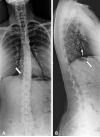Early-onset osteoarthritis in Ehlers-Danlos syndrome type VIII
- PMID: 22419391
- PMCID: PMC3314117
- DOI: 10.1002/ajmg.a.35261
Early-onset osteoarthritis in Ehlers-Danlos syndrome type VIII
Figures





References
-
- Biro F, Gewanter HL, Baum J. The hypermobility syndrome. Pediatrics. 1983;72:701–706. - PubMed
-
- Castori M, Camerota F, Celletti C, Danese C, Santilli V, Saraceni VM, Grammatico P. Natural history and manifestations of the hypermobility type Ehlers–Danlos syndrome: A pilot study on 21 patients. Am J Med Genet. 2010;152:556–564. - PubMed
-
- Karachalios T, Zibis A, Papanagiotou P, Karantanas AH, Malizos KN, Roidis N. MR imaging findings in early osteoarthritis of the knee. Eur J Radiol. 2004;50:225–230. - PubMed
-
- Karrer S, Landthaler M, Schmalz G. Ehlers–Danlos type VIII. Review of the literature. Clin Oral Investig. 2000;4:66–69. - PubMed
-
- Moore MM, Votava JM, Orlow SJ, Schaffer JV. Ehlers–Danlos syndrome type VIII: Periodontitis, easy bruising, marfanoid habitus, and distinctive facies. J Am Acad Dermatol. 2006;55:S41–S45. - PubMed
Publication types
MeSH terms
Grants and funding
LinkOut - more resources
Full Text Sources
Medical

